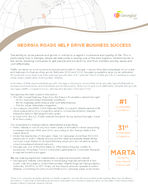PA CIFIC
A TLA N TIC
O
C
E
GEORGIA
AN
ROADS
HELP
DRIVE
BOUC SE AINNESS
SUCCESS
The ability to move people and goods is critical to a region's commerce and quality of life. This is particularly true in Georgia, where we take pride in having one of the best logistics infrastructures in the world, allowing companies to get people and products to and from markets quickly, easily and cost-effectively.
Traffic increases as more businesses and people locate to Georgia -- and as they take advantage of our roads and highways for transporting goods. Between 2000 and 2009, Georgia's population grew by an estimated 18.3 percent, more than twice the national growth rate of 9.7 percent. Much of that growth is centered in major urban areas, particularly metropolitan Atlanta.
In the face of that unprecedented growth, Georgia is striving to ensure that roads are safe, transit alternatives increase and businesses and individuals are incentivized to think, move and work differently. Despite the growth, Georgia's traffic congestion hours decreased between 2005 and 2009.
Georgia has the best roads in the nation The 19th Annual Highway Report by the Reason Foundation ranked Georgia1
- 1st for rural and urban interstate conditions - 9th for highway performance and cost-effectiveness - 31st for urban interstate congestion According to the INRIX 2009 National Traffic Scorecard, Atlanta ranked 20th when measured by how congestion adds to normal travel times (despite being the nation's 8th largest metro area). In April 2010, the U.S. Public Interest Research Group ranked Georgia's roads #1 in the country.
#1
in interstate
conditions
Our incentives for transportation alternatives are working Metro Atlanta is one of only four metro areas in the nation where carpooling
increased between 1990 and 2000, according to the Transportation Research Board. Under the leadership of Georgia's Clean Air Campaign more than 300,000 employees in metro Atlanta and around the state are already teleworking once per week, thanks to forward-thinking employers, tax incentives and a robust broadband internet network. Georgia was one of the first states to offer teleworking tax credits to businesses. More than 70,000 commuters participate in Commuter Rewards, a regional incentive program.
We are making significant investments in regional and public transit Georgia and Atlanta were leaders in developing regional rail transit in the
South, with the creation of the Metropolitan Atlanta Regional Transportation Authority (MARTA) in 1971. Today, six bus transit services operate in metro Atlanta: connecting Downtown and Midtown to suburban areas everywhere.
31st
in interstate congestion
MARTA
model for mass transit in the South
1There is no universally accepted definition of traffic congestion, but the 19th Annual Nationwide Highway Report by the Reason Foundation, in reporting to the federal government, used peak-hour volume-to-capacity ratios, as calculated in the Transportation Research Board's Highway Capacity Manual.
1.4 million
daily miles not driven
$2.8 billion
for BeltLine project
$110 million
for congestion reduction
86%
of freight moved by truck
The Atlanta BeltLine, a $2.8 billion project, will shape the way Atlanta grows throughout the next several decades. It is among the widestranging urban redevelopment projects in the country: a 22-mile loop of railroad corridor with pedestrian-friendly access to 45 neighborhoods, with connections to existing MARTA stations and future transit system stops, such as the streetcars and commuter rail lines.
In October 2010, Atlanta's planned streetcar project received a boost of $47.6 million from the federal government. The streetcar will follow a 12stop, 2.6-mile route with direct transfers to MARTA. The Atlanta Community Improvement District plans to provide $10 million for the project and the city of Atlanta another $15 million as part of the local costs match.
WE ARE TAKING TANGIBLE STEPS TO SECURE OUR FUTURE
Elected officials from across Georgia came together in support of the Transportation Investment Act of 2010: - Signed into law in June 2010, the legislation allows each of the state's 12 regions to self-fund transportation improvements. In 2012, residents in each region will have the opportunity to review proposed projects before voting whether to tax themselves for those improvements. - The National League of Cities praised the bill for its regional cooperation, calling it a "breakthrough" and a "fascinating model" for addressing transportation challenges in a diverse state.
With a $110 million Congestion Reduction Demonstration program grant, metro Atlanta's HOV lanes, will be converted into a 49-mile integrated network of High Occupancy Toll lanes along I-85, I-75 and I-20. The plan includes enhancements such as new express service buses, expanded park and ride facilities and an orderly flow of transit into and out of Atlanta's major office sub-markets such as Downtown, Midtown and Buckhead.
The Georgia Department of Economic Development and the Department of Transportation in 2010 announced the creation of Georgia's first comprehensive, statewide freight and logistics plan. This plan will address logistics needs through the year 2050, guiding the strategic execution of logistics activities and projects to improve the flow of goods into, within and out of the state.
An inland port currently under construction in Cordele, GA, will boost business at the Port of Savannah and reduce truck traffic in the metro Atlanta region. The $8.6 million intermodal terminal will serve as a transfer point for containerized cargo trucked in and to be shipped by rail to Savannah.
Georgia has implemented several effective traffic solutions: HERO units, which respond quickly to clear highway incidents; Georgia Navigator, a congestion tracking website; the TRIP program, which expedites cleanup of tractor-trailer highway crashes; and entrance ramp meters.
In Georgia, we move businesses forward.
03/2011
Georgia Department of Economic Development I 75 Fifth Street, NW, Suite 1200, Atlanta, GA, 30308 I 404.962.4034 I georgia.org
